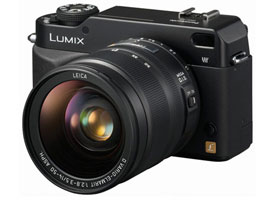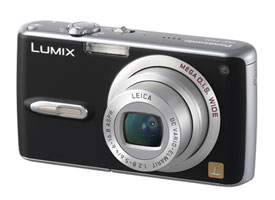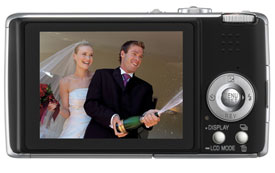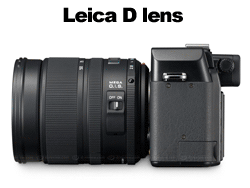 Panasonic's Pixels Worth Thousands of Words
Panasonic's Pixels Worth Thousands of Words
By Jim Bray
Digital cameras have certainly come a long way quickly.
Where once they were almost exclusively the "instamatic" type of
point and shoot consumer camera, bare bones and low res, they've now evolved
to the point where consumers can take pictures like a pro, while pros have
even less reason than before to continue with their particular brand of "negative
thinking."
I recently played with a couple of Panasonic's newest digital cameras, one
from near each end of their line, and came away impressed with what you can
now do affordably – and intimidated by just how sophisticated a high
end digital camera can be.
You could almost call it "The tale of the Lumix and the Lummox."
 The Lumix is Panasonic's Lumix FX-07, a lovely little point and shoot camera
that fits into (and falls out of, if you aren't careful!) a shirt pocket and
is full of thoughtful features that really endeared it to me.
The Lumix is Panasonic's Lumix FX-07, a lovely little point and shoot camera
that fits into (and falls out of, if you aren't careful!) a shirt pocket and
is full of thoughtful features that really endeared it to me.
The "Lummox" is Panasonic's heavy duty Lumix DMC-L1 digital SLR,
a camera that brought to mind my old Pentax film camera and other SLR's of the
rapidly ending "analog" age. This is a far better camera than I am
a photographer, yet if you want to leave it on its automatic settings (which,
though convenient, is kind of a waste of features in this case, methinks) you
can still create breathtaking shots without expending any skull sweat.
The cameras share variations of many features, such as Panasonic's Venus engine,
the image processor that's the heart of the company's digital cameras and which
they say helps achieve "shutter release lag of less than .006 second".
They also share the Optical Image Stabilization theme that holds the picture
steady even if you're off your meds and an F2.8 wide angle view that lets you
get more background into your shots that you might imagine.
That wide angle worked out really well for me in my tests using the FX-07.
I took it to some particularly touristy locations and was amazed at just how
much stuff I could get into the frame besides my human subjects. One memorable
series of shots had my wife and son standing in front of a row of totem poles
and, thanks to the Lumix, I got the whole row in, something my reference digital
camera wouldn't do.
Panasonic also includes a "high angle LCD function" which means
you can hold the camera up high above your head and still make out what's on
the little screen (within reason, of course). This could be handy if, for example,
you're trying to shoot a parade and there are taller people in front of you – and
it works well.
 A Little Lulu….
A Little Lulu….
The Lumix FX-07 is a 7.2 megapixel unit that features a Leica DC Vario-Elmarit
lens with a 3.6x optical zoom. And if you lower the resolution you can extend
the zoom to 5.5x. This may not seem like a lot, perhaps, but it was enough
in my "real world" test to bring a bear high up on a mountainside
into good view. Remember, this isn't meant to be a professional camera.
The FX-07 comes with a 2.5 inch LCD monitor on its rear panel that displays
207,000 pixels, and it also features high-speed auto focus, continuous burst
shooting mode and, as with most digital cameras these days, you can also use
it to record video (with audio), in this case at 640 x 480 pixels (30 frames
per second in 4:3 standard mode) or 848 x 480 pixels (30 fps in 16:9 widescreen
mode). Panasonic claims you can get up to 320 Shots on a single charge of the
lithium ion battery that's included in the box.
Here's
a list of more features:
- AF Assist lamp
- ISO sensitivity settings (Auto/100/200/400/800/1250)
- High-sensitivity mode (ISO 3200)
- Real-time histogram
- Composition guidelines
- Auto angle detection
- Built-in flash
- White balance adjustment
- Color effect mode
- Scene mode help screen
- Exposure compensation
The little Lumix is really handy and it's very easy to use. I used it on automatic
most of the time, and it worked just fine, and of course you can opt for the
more manual features if you want. The pictures I got from the FX-07 were excellent,
despite having been shot in a variety of lighting conditions.
Panasonic lists the FX-07 for $350U.S./$480 Canadian.
 Big Shots….
Big Shots….
But if that isn't enough for you, the Lumix DMC-L1 is definitely a serious
camera!
It's big and bulky compared with the pocket sized FX-07, but not if you compare
it with the film-based SLR's (Single lens reflex) it's designed to replace.
It features interchangeable lenses just like a "real" camera, and
positively bristles with buttons, knobs and gewgaws.
The camera "feels" like an analog camera in use, comfortable in the
hands and easily familiar for those who want the security blanket of an "old
fashioned" film camera body. You can check your settings using the 2.5
inch LCD monitor on the back, the aperture ring turns with your left hand,
like it should, and the shutter dial can be twisted with your right hand while
you're holding the camera. As I said, it feels just like a "real" camera.
Though it's been years since I've used a "real" SLR, this Panasonic
felt just right and operates with the tactile feel and audible "clicks" that
tell you when you've made a manual adjustment that it has, indeed, taken effect.
As mentioned above, the L1 is a far better camera than I am a photographer,
so I was more than a tad intimidated by it. It's so flexible and sophisticated
that you'll want to spend some time with the manual if you plan to really exploit
it.
On the other hand, you can just leave it on automatic and shoot away to your
heart's content, though that's kind of a waste of its outrageously long list
of features. But my results, even on the automatic settings (or, perhaps, because I
used the automatic settings!), were great.
Here's a quick list of some DMC-L1 features that nearly scratches the surface:
- 7.5 Megapixels Live MOS sensor
- Venus Engine III Processor
- Supersonic Dust Reduction System
- Aperture Ring & Shutter dial
- 2.5” High-resolution LCD with Live View function
- Film mode
- Built-in bounce flash (pantograph type)
- Magnesium-alloy body
- Aperture preview
- "Intelligent ISO" (with sensitivity settings Auto/100/200/400/800/1600)
- Advanced White Balance Adjustment
- Manual Focus Assist
- Accurate TTL (through the lens) Auto Focus
- Multiple Aspect Ratios (4:3/3:2/16:9)
- Hot Shoe
Then there's the Leica D lens that comes in the box, which Panasonic says
is the first Leica designed specifically for a digital SLR:
- Leica D VARIO-ELMARIT 14-50mm lens (35mm equivalent: 28-100mm)
- F2.8 (wide) - 3.5 (Tele)
- 16 elements in 12 Groups (2 aspherical lenses)
- Four Thirds mount
- MEGA Optical Image Stabilizer (Mode 1/2)
All for $1995 U.S./$2399 Canadian! Okay, that's a lot of green for a digital
camera, but this is one heck of a digital camera. Heck, you even get a dust
reduction system designed to keep crud off the image sensor when you change
lenses.
Panasonic is obviously going after the serious photographer here, though
it may be facing a bit of an uphill battle in a marketplace where names such
as Nikon and Canon are more traditionally thought of than Panasonic. But with
its Lumix DMC-L1 digital SLR, the company has come up with a model that deserves
consideration by professionals looking to move to the digital domain.